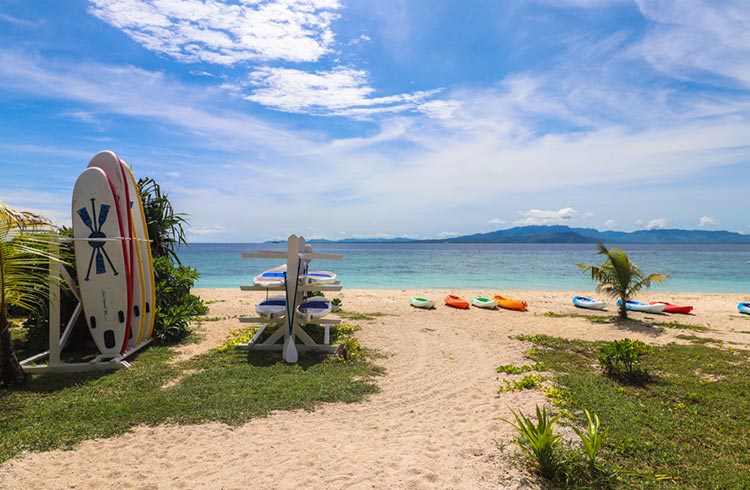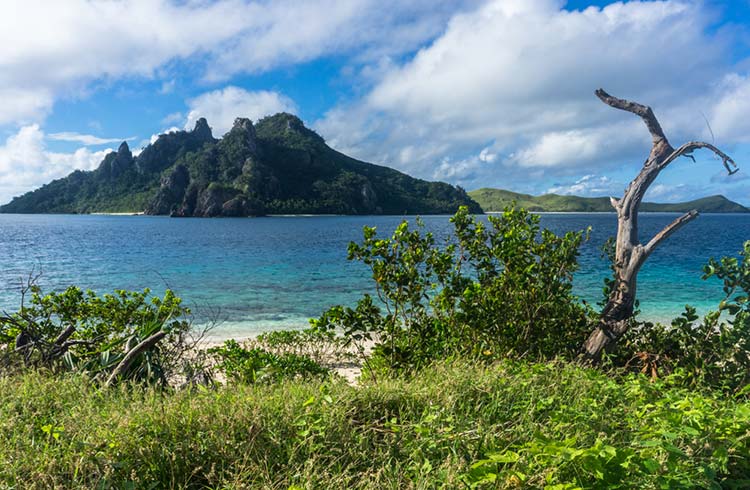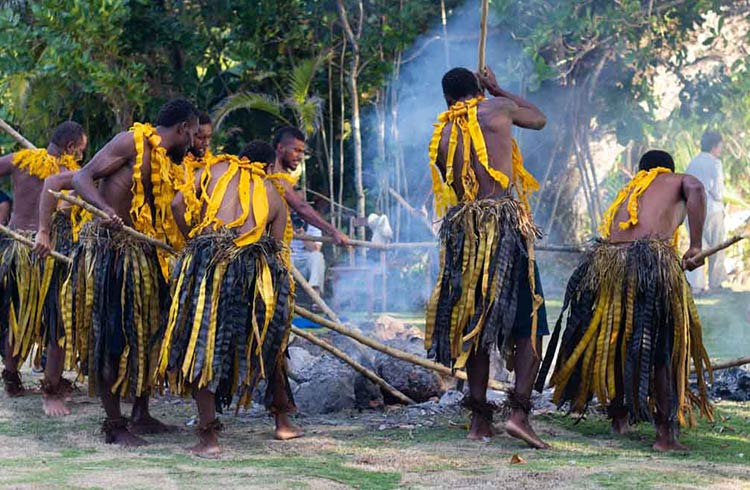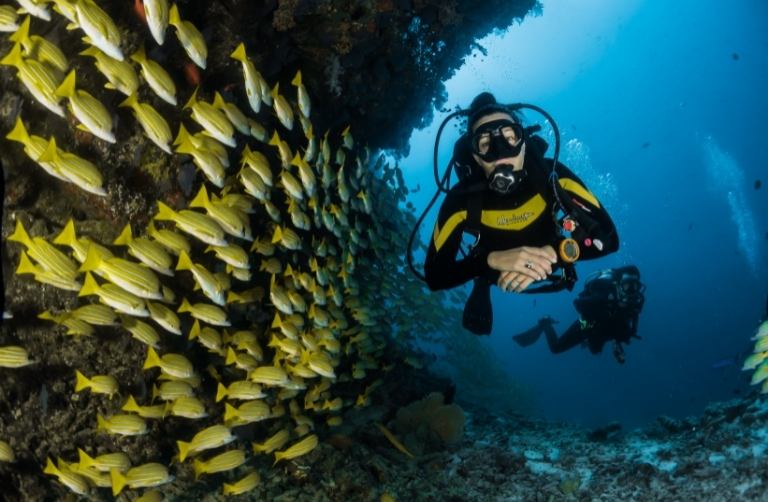Think of the Fiji islands and you’ll rightly imagine a South Pacific paradise. Our Fiji travel guide tells you what to know about travel costs, local traditions, Fijian food, and getting off the beaten track.
 Photo © Chantae Reden
Photo © Chantae Reden
Six years ago, I moved to Fiji planning to stay a year or two. I soon fell in love with Fiji’s landscapes, friendly “Bula!” spirit, colorful marine life, and a lifestyle that lends itself to being part of a community. I have no intention of leaving anytime soon.
Here are seven things to know before you visit Fiji.
- Is Fiji expensive?
- Best time to visit Fiji
- Fiji etiquette
- Kava drinking in Fiji
- Fiji off the beaten track
- How to experience Fijian culture
- Traditional Fijian food
Is Fiji expensive? What to know about Fiji travel costs
Fiji is an expensive country to travel around, especially if you plan on island hopping. While there are plenty of accommodations to choose from on the main island of Viti Levu, options are limited once you reach the outer islands. To find an affordable bed rate, look for backpacker hostels and guesthouses. Some resorts, such as a handful in the Mamanuca and Yasawa Islands, offer an overall upscale experience with dorm room options.
Before you book, factor in the cost of the room, transport, mandatory meal plans, and adventure activities you’ll want to do – such as scuba diving or snorkeling. This will give you a more realistic picture of what you’ll spend, as many accommodations have low room rates but high meal plan and activity rates. It’s worth sticking to a few islands than seeing many at once. Expenses rack up every time you step foot on a boat or plane.
If you’re on one of the larger islands, keep costs down by shopping at local markets where produce and snacks are sold at lower prices. Taking the bus or even a metered taxi will often be cheaper than hiring transport through your hotel.
Best time to visit Fiji
There’s no truly bad time to visit Fiji. The best weather is from June to September, when skies are sunny and temperatures hover in the high 20ºCs (low 80ºFs). With these months aligning with school holidays, this is also when accommodation prices spike. Fortunately, because resorts are spread out among the islands, you’re unlikely to notice the crowds. If you want nice weather with lower accommodation prices, visit in May or October.
Fiji’s cyclone season runs from November to April, which are also the hottest months of the year. And while it can seem risky to come during cyclone season, most days still bring in pleasant weather.
No matter what time of year you visit, bring reef-safe sunscreen and a rain jacket. It’s not unheard of to have bluebird skies in the morning, and a moody downpour come afternoon. Lightweight, sun protective clothing works well as a wardrobe staple in Fiji – bright colors and tropical patterns encouraged.

Fiji etiquette: visiting local villages
Whenever you enter a new village, it’s customary to bring a gift and participate in a gift-giving ceremony called a sevusevu. Walking into an unknown village without a sevusevu is often seen as disrespectful. A bundle of yaqona, pepper root that is pounded into kava, is well-received, and you can purchase it at most major markets. The head of the village, called the Turaga ni Koro, and other community members may share kava with you as a welcome into the community.
Bringing a sevusevu often lets you explore the village’s surrounding areas. Don’t be surprised if you’re invited to a church service, someone’s home for tea, or the school for a tour. If you travel to a village with a guide, they’ll likely sort out all logistics for your arrival.
When you enter a village, avoid wearing anything on your head – no hats or sunglasses allowed. Hold your backpacks in your hand rather than on your back. For both men and women, it’s polite to wear a sulu, or sarong, whenever you’re on village property.
Drinking kava in Fiji
Kava, a relaxing, earthy drink made from ground pepper root, is Fiji’s drink of choice. After two bilos (coconut shell bowls), your lips might start to tingle. After three or four, you’ll feel like you’ve arrived on island time.
Drinking kava with others goes well beyond the drink itself – the act of it is steeped in Fijian tradition and there are a few etiquette points to follow whenever you’re seated around a tanoa, a wooden bowl. Kava is served everywhere from work functions to ceremonies to sporting events to backyard barbecues. Communities often resolve problems over a bowl of kava, rather than through formal routes or emails.
The leader of the group will be seated at the ‘head’ of the bowl and typically served first. When you’re served a bilo, clap and drink the entire coconut shell in one go. Many communities consider it polite to receive and hand back the bilo with both hands. Once you’re done, clap and say “Bula!” – a nod to good health. If you can, drink the full bilo the first time it’s offered. Feel free to politely skip subsequent rounds or ask for “low tide,” a small portion. When in doubt, a big smile and a hearty “Bula” will carry you through any social situation.
Fiji off the beaten track: other islands to visit
It might seem like Denarau is the best region to visit as it’s where you’ll find most of Fiji’s large resorts. However, it lacks the postcard-perfect beaches you might’ve come for, and you’re somewhat detached from Fijian culture. Some travelers trail along Viti Levu’s Coral Coast. Others will jet off to the Mamanuca and Yasawa Islands. These stops make up the majority of Fiji’s tourist trail.

However, if you’re looking for an experience where drinking kava and dancing is more of a way of life than a performance, head to Fiji’s outer islands or into Viti Levu’s interior. Taveuni, Fiji’s so-called “Garden Island” offers waterfall hikes and world-class scuba diving. Ovalau is home to Fiji’s old capital, Levuka, and villages where locals are happy to teach you about Fiji’s history. For incredible snorkeling and scuba diving, venture towards Kadavu, an emerald island surrounded by the Great Astrolabe Reef. To see the most remote islands in Fiji, take a cruise to the Lau Archipelago. What it lacks in accommodations and airport strips, it makes up for in natural beauty and Fijian hospitality.
Local operators such as Finding Islands Tours can arrange an overnight stay in a village as well as off-the-beaten-path hikes, camping trips, and boat trips. No two trips are exactly alike.
How to experience Fijian culture
Fiji is one of the few places in the world where it feels like magic still exists. On the island of Beqa, you’ll have a chance to see Fiji’s traditional firewalkers. Instead of someone trotting across hot coals as you might’ve seen in a street performance, stones are placed in a fire pit for hours. Men then perform a ceremony and walk across stones so hot you can feel the heat radiating from them even from a distance. This skill has been passed down through generations. Legend says it was given to Beqa after a Fijian warrior freed a spirit god that lived within an eel. In return the spirit god gave the warrior the power to walk without being burned.

If you get the chance, attend a meke, a performance of song and dance. Performers drape themselves in bark cloth painted in Fijian patterns, called tapa, and tell stories through movement. This is also an opportunity to see Fiji’s traditional weaponry – wooden clubs, spears, and fire tools add to the excitement of each song.
As Fiji is a culture founded by the world’s best seafarers, visit the Fiji Museum in Suva to learn about the art of ancient sailing. There, you’ll find a replica drua, a traditional sailing canoe, that once crossed the South Pacific. The Uto Ni Yalo is a 72-foot sailing canoe that still cruises through Fiji’s waters and occasionally offers sailing tours for visitors.
Traditional Fijian food
On my first trip to Fiji, I wasn’t surprised to find heaps of fresh tropical fruits sold at the markets. Pineapples, papayas, mangoes, bananas, soursops, and more are ubiquitous around the islands depending on the season.
However, I was surprised to discover just how varied Fijian cuisine can be. Enjoy refreshing coconut shells filled with kokoda, fresh fish marinated in lime juice and served with coconut milk, cucumber, onion, and tomato. A local spinach dish, called pulasami, is made with bundles of taro leaves cooked with coconut and onion in an underground oven called a lovo. This lovo is also used to cook meat and seafood – firing it up typically calls for celebration. Salads made from sea grapes (nama) and small fern leaves (ota) drizzled in lime juice and coconut milk are the perfect after-sun snack.
According to a recent census, nearly 33% of Fiji’s population is of Indian descent. This means you’ll find tasty Indian-Fijian fare all throughout Fiji’s major cities of Nadi, Suva, Lautoka, and Labasa. Bus stations and markets sell delicious roti parcels stuffed with spiced curry for around USD $1. One dish you can’t miss? Jackfruit curry made with jackfruit, onion, garlic, turmeric, curry powder, chili powder, cumin, and a dash of decadent coconut cream.
World Nomads travel insurance plans offer cover for more than 150 adventure sports and activities, including hiking, kayaking, scuba diving, and sailing. Find out more.
Related articles
Simple and flexible travel insurance
You can buy at home or while traveling, and claim online from anywhere in the world. With 150+ adventure activities covered and 24/7 emergency assistance.
Get a quote

16 Comments